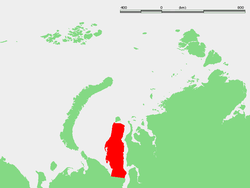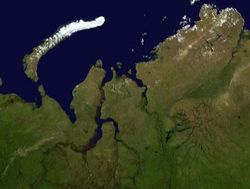شبه جزيرة يمال
70°40′15″N 70°08′12″E / 70.67088°N 70.13672°E
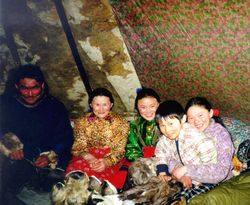 عائلة ننتسية. |
شبه جزيرة يمال (روسية: полуо́стров Яма́л، Yamal Peninsula)، هي شبه جزيرة تقع في مقاطعة يمال-ننتس ذاتية الحكم في شمال غرب سيبريا، روسيا. تمتد بطول 700 كم ويحدها بحر كارا، خليج بايداراتسكايا من الغرب، وخليج أوب من الشرق. بلغة سكانها الأصليين، النـِنـِتس، تعني "يمال" "نهاية العالم".
يغلب على معظم أراضي شبه الجزيرة التربة الصقيعية وتعتبر صغيرة جداً من الناحية الجيولوجية حيث يصل عمر بعض المناطق أقل من عشرة آلاف سنة. [بحاجة لمصدر]
تشهد المنطقة مشروعات تنموية واسعة النطاق، حيث يجري العمل على ثلاث مشروعات بنية تحتية عملاقة - سكك حديد اوبسكايا-بوڤاننكوڤو بطول 572 كم والذي كان من المفترض اكتماله في 2011، خط أنابيب غاز، والعديد من الجسور.[1] تضم يمال أكبر الاحتياطيات الروسية (والعالمية) من الغاز الطبيعي.[بحاجة لمصدر] كانت شركة الغاز الروسية گازپروم تخطط لتطوير حقل يورخاروڤسكويه للغاز فيما بين 2011-2012. تقدر احتياطيات الغاز في الحقل ب55 تريليون متر مكعب.[1] أكبر مشروعات الطاقة الروسية، الذي يعرف بمشروع يمال، يشكل خطراً على مستقبل رعاة الرنة الرحل في المنطقة.[بحاجة لمصدر]
عثر على بقايا بحالة جيدة، ليوبا، الماموث الذي يعود إلى 37.000 سنة، عثر عليه راعي رنة على شبه الجزيرة في صيف 2007. كان الحيوان أنثى وقدر عمرها بشهر واحد،[2] وقت وفاتها.[3][4]
حفرة يمال
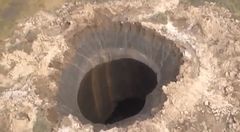
في يوليو 2014، تمكن طاقم حوامة روسية يعمل في حقول النفط والغاز في شبه جزيرة يمال من اكتشاف حفرة عملاقة مجهولة المنشأ. ووفقاً للطاقم، أن الحفرة كبيرة جداً إلى درجة أن قاعها يتسع لعدة مروحيات من طراز مي-8. وفي الجزء السفلي للحفرة يجري نهر تحت الأرض يمتد على نطاق واسع. التربة حول الحفرة قد خرجت من داخل الحفرة إلى الأطراف. أما لونها الداكن فيشير إلى التعرض لدرجات الحرارة العالية. وبالتالي، يمكن أن يكون سبب تشكل هذه الحفرة هو انفجار يساوي بقوته انفجار قنبلة ذرية صغيرة مع العلم أنه لم تجر هناك أي اختبارات تفجيرية. [6]
الجغرافيا

The peninsula consists mostly of permafrost ground and there are numerous lakes of thermokarst origin, the biggest of which are Neito and Yambuto in the central part.[7][8]
Many hydrocarbon fields have been discovered on the Yamal Peninsula, including large gas fields. The main hydrocarbon resources are concentrated in the permeable Aptian-Cenomanian complex.[9]
تربية حيوان الرنة
According to anthropologist Sven Haakanson, the Yamal peninsula is the place within the Russian Federation where traditional large-scale nomadic reindeer husbandry is best preserved.[10][11] Nenets and Khanty reindeer herders hold about half a million domestic reindeer.
التنمية
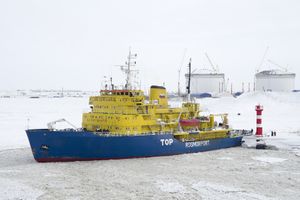
The area is largely undeveloped, but work is ongoing with several large infrastructure projects, including a gas pipeline and several bridges.[1] Yamal holds Russia's biggest natural gas reserves.[12] The 572 km Obskaya–Bovanenkovo railway, completed in 2011, is the northernmost railway in the world.[13] Russian gas monopolist Gazprom had planned to develop the Yurkharovskoye gas field by 2011–2012. The peninsula's gas reserves are estimated to be 55 trillion cubic meters (tcm).[1] Russia's largest energy project in history, known as the Yamal project, puts the future of nomadic reindeer herding at considerable risk.[بحاجة لمصدر]
فوهات يامال
In 2014, Yamal was the discovery site of a distinct sinkhole, or pingo, which quickly drew the attention of world media.[14] The sinkhole appeared to be the result of a huge explosion and several hypotheses were suggested to explain the formation of the crater, including a hit by a meteorite or a UFO, or the collapse of an underground gas facility.[15]
A spokesperson for the Yamal branch of the Emergencies Ministry said, "We can definitely say that it’s not a meteorite.".[16] Cryovolcanism has been pointed out as the most probable cause in recent researches.[17]
The 60-meter (66-yard) crater is believed by a senior researcher from the Scientific Research Center of the Arctic, Andrei Plekhanov, in remarks to the Associated Press, to be likely the result of a "buildup of excessive pressure" underground because of warming regional temperatures in that portion of Siberia.[18] Tests conducted by Plekhanov's team showed unusually high concentrations of methane near the bottom of the sinkhole.[19][20]
The destabilization of gas hydrates containing huge amounts of methane gas is believed to have caused the craters on the Yamal Peninsula.[21]
As of 2015, the Yamal peninsula had at least five similar craters.[22]
Another crater appeared in August 2020.[23]
تسرب الميثان في البحر
According to researchers at Norway's Centre for Arctic Gas Hydrate (CAGE), through a process called geothermal heat flux, the Siberian permafrost, which extends to the seabed of the Kara Sea, a section of the Arctic Ocean between the Yamal Peninsula and Novaya Zemlya, is thawing. According to a CAGE researcher, Aleksei Portnov:[21]
"The permafrost is thawing from two sides... [T]he interior of the Earth is warm and is warming the permafrost from the bottom up. It is called geothermal heat flux and it is happening all the time, regardless of human influence."
— CAGE 2014
"The thawing of permafrost on the ocean floor is an ongoing process, likely to be exaggerated by the global warming of the world´s oceans."
— CAGE 2014
Methane is leaking in an area of at least 7500 m2. In some areas gas flares extend up to 25 m (82 ft). Prior to their research it was proposed that methane was tightly sealed into the permafrost by water depths up to 100 m (330 ft). Close to the shore however, where the permafrost seal tapers to a depth of as little as 20 m (66 ft), there are significant amounts of gas leakage.[21]
الاقتصاد
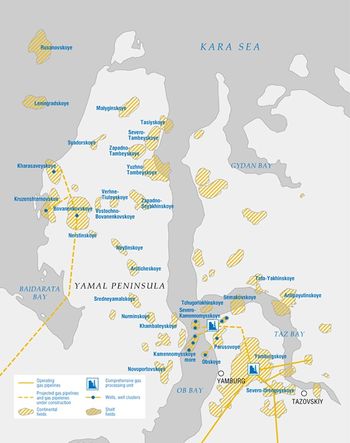
انظر أيضاً
المصادر
- ^ أ ب ت ث Yamal peninsula: The world's biggest gas reserves خطأ استشهاد: وسم
<ref>غير صالح؛ الاسم "guardian" معرف أكثر من مرة بمحتويات مختلفة. - ^ Ice Baby — National Geographic Magazine, May 2009
- ^ Baby mammoth unearthed in Yamal is 37,000 years old - scientists
- ^ NY Times 11 July 2007 Story
- ^ "Mysterious giant hole suddenly appears in Siberia". sploid.gizmodo.com. 2014-07-16. Retrieved 2014-07-16.
- ^ "العثور على حفرة عملاقة غامضة في شبه جزيرة يامال". صوت روسيا. 2014-07-13. Retrieved 2014-07-16.
- ^ "R-41_42 Topographic Chart (in Russian)". Retrieved 6 June 2022.
- ^ Google Earth
- ^ Surikova, E S; Solmin, A E; Guseva, S M (30 October 2018). "Regional model of the geological structure of the Yamal and Gydan oil-and-gas areas". IOP Conference Series: Earth and Environmental Science. 193 (1): 012067. Bibcode:2018E&ES..193a2067S. doi:10.1088/1755-1315/193/1/012067.
- ^ Haakanson, Sven, Reindeer herders, Yamal Culture, Washington: Smithsonian National Museum of Natural History, http://www.mnh.si.edu/arctic/html/yamalcu.html, retrieved on 28 December 2014
- ^ Haakanson, Sven David (2000). Ethnoarchaeology of the Yamal Nenets: Utilizing Emic and Etic Evidence in the Interpretation of Archaeological Residues. Ethnoarchaeology (PhD). Harvard University. pp. 472 pages.
- ^ "Yamal megaproject". Gazprom.com. Retrieved 2016-04-12.
- ^ "Obskaya–Bovanenkovo Railroad". Railway Technology. Retrieved 2016-04-12.
- ^ Gates, Sara (16 July 2014). "Giant hole forms in Siberia, and nobody can explain why". HuffPost. Retrieved 28 December 2014.
- ^ Bogoyavlensky, Vasily (October 2015). "Gas Blowouts on the Yamal and Gydan Peninsulas" (PDF). GEO ExPro. Vol. 12, no. 5. GEO Publishing Ltd. pp. 74–78. ISSN 1744-8743. Retrieved 27 July 2016.
- ^ Winter, Lisa (16 July 2014). "Huge Crater Mysteriously Appears in Siberia". IFL Science. Retrieved 5 August 2014.
- ^ Buldovicz, Sergey N.; Khilimonyuk, Vanda Z.; Bychkov, Andrey Y.; Ospennikov, Evgeny N.; Vorobyev, Sergey A.; Gunar, Aleksey Y.; Gorshkov, Evgeny I.; Chuvilin, Evgeny M.; Cherbunina, Maria Y.; Kotov, Pavel I.; Lubnina, Natalia V.; Motenko, Rimma G.; Amanzhurov, Ruslan M. (10 September 2018). "Cryovolcanism on the Earth: Origin of a Spectacular Crater in the Yamal Peninsula (Russia)". Scientific Reports (in الإنجليزية). 8 (1): 13534. Bibcode:2018NatSR...813534B. doi:10.1038/s41598-018-31858-9. ISSN 2045-2322. PMC 6131154. PMID 30202065.
- ^ "News". news.msn.com. Archived from the original on 11 August 2014. Retrieved 23 December 2017.
- ^ Moskvitch, Katia (2014). "Mysterious Siberian crater attributed to methane". Nature. doi:10.1038/nature.2014.15649. S2CID 131534214. Retrieved 23 December 2017.
- ^ Luntz, Stephen (2 August 2014). "Scientists May Have Solved The Siberian Crater Mystery". Business Insider. Retrieved 5 August 2014.
- ^ أ ب ت Sojtaric, Maja (18 December 2014), Methane is leaking from permafrost offshore Siberia, Tromsø, Norway: Centre for Arctic Gas Hydrate (CAGE), https://cage.uit.no/news/methane-leaking-permafrost-seal-offshore-siberia/, retrieved on 28 December 2014
- ^ Winter, Lisa (26 February 2015). "There are more bizarre craters opening up in Siberia, and scientists still don't know what's causing them". businessinsider.com. Retrieved 27 July 2016.
We know now of seven craters in the Arctic area. Five are directly on the Yamal peninsula, one in Yamal Autonomous district, and one is on the north of the Krasnoyarsk region, near the Taimyr peninsula,...
- ^ Liesowska, Anna (29 August 2020). "Giant new 50-metre deep crater opens up in Arctic tundra". siberiantimes.com. Retrieved 30 December 2023.
وصلات خارجية
- Ялмал, статья ЭСБЕ (بالروسية)
- Статья БСЭGreat Soviet Encyclopedia (بالروسية)
- Yamal Culture (إنگليزية)
- Yamal Peninsula Nenets (إنگليزية)
- Pages using gadget WikiMiniAtlas
- Coordinates on Wikidata
- Articles containing روسية-language text
- Pages using Lang-xx templates
- مقالات ذات عبارات بحاجة لمصادر
- Articles with unsourced statements from July 2014
- Articles with hatnote templates targeting a nonexistent page
- أشباه جزر في روسيا
- جغرافيا اوكروگ يمالو-ننتس ذاتي الحكم
